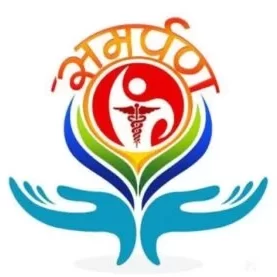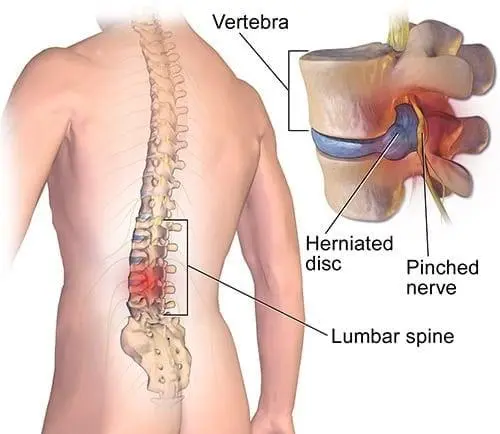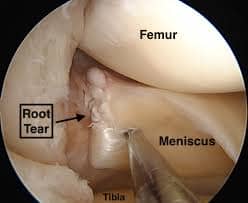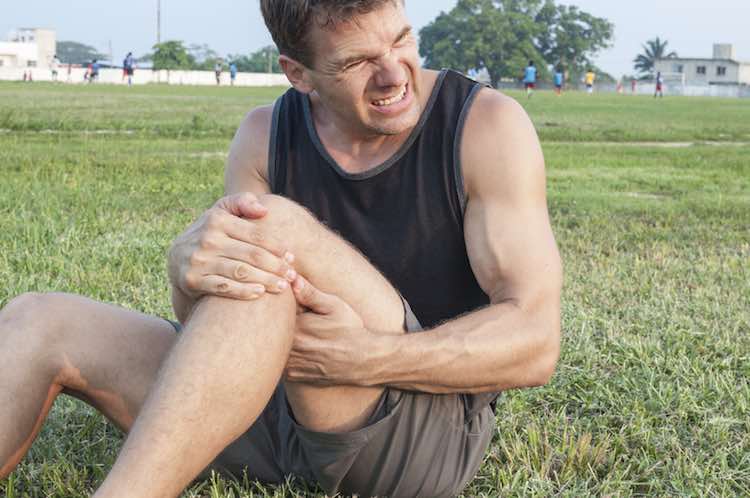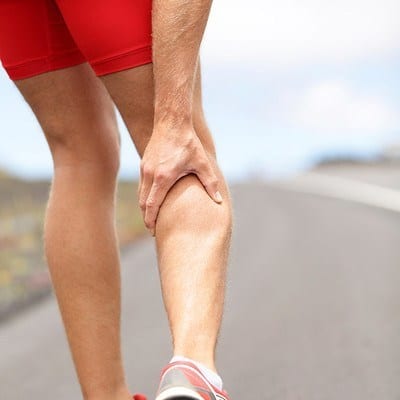Herniated Disk
An issue with one of the rubbery cushions, known as disks, that sit between the bones that stack to form the spine, is known as a herniated disk. We refer to these bones as vertebrae.
The nucleus is the soft, jelly-like core of a spinal disk. The annulus, a harder, rubbery outer layer, surrounds the nucleus. When part of the nucleus pushes out through an annular tear, it is known as a herniated disk. A ruptured disk or a slipped disk is another name for a herniated disk.
The lower back is the most common location for a herniated disk, though it can happen anywhere along the spine. An arm or limb may experience pain, numbness, or weakness, depending on the location of the ruptured disk.
Table of Contents
Symptoms
Herniated disks can happen in the neck, although they usually happen in the lower back. The location of the disk and whether it is pushing against a nerve determine the symptoms. One side of the body is frequently affected by herniated disks.
- Leg or arm discomfort. You will usually have discomfort in your lower back, buttocks, thigh, and calf if your herniated disk is located in your lower back. You may also have discomfort in a portion of your foot.
- You will usually have the most discomfort in your arm and shoulder if you have a herniated disk in your neck. When you cough, sneeze, or assume specific positions, this discomfort may radiate into your arm or leg. Sharp or searing pain is a common description.
- Tingling or numbness. In the area of the body that the damaged nerves serve, people with herniated disks frequently experience radiating tingling or numbness.
- Weakness. Nerves that are impaired often cause their muscles to weaken. This may impair your ability to lift or grip objects or make you trip.
Causes
The most common cause of disk herniation is disk degeneration, a slow, age-related wear and strain. The disks grow less flexible with age and are more likely to rip or rupture at the slightest twist or pressure.
Most people are unable to identify the reason behind their ruptured disk. A herniated disk can occasionally result from lifting large things with the back muscles rather than the leg and thigh muscles. A herniated disk can also result from twisting and rotating when lifting. A traumatic incident, such as a fall or a hit to the back, is rarely the reason.
Risk factors
The following variables may make a herniated disk more likely:
- Weight. Excess body weight puts additional strain on the lower back’s disks.
- profession. Individuals who work in physically demanding occupations are more likely to experience back issues. An increased risk of a herniated disk can also result from repetitive lifting, pushing, tugging, sideways bending, and twisting.
- Genetics. A herniated disk is a condition that certain people are predisposed to.
- Smoking. Smoking is believed to reduce the oxygen flow to disks, hastening their decomposition.
- Frequent driving. The combination of prolonged sitting and the vibration from a car engine can strain the spine.
- Being inactive. A herniated disk can be avoided with regular exercise.
Diagnosis and Tests
How do you identify a herniated disk?
A comprehensive physical examination will be performed by your healthcare practitioner. Your healthcare professional will evaluate your discomfort, sensitivity, muscular strength, and muscle reflexes during the examination. A straight leg lift test might be one of their options. Your provider will ask you to lie on your back during this test. They will then lift your leg straight up into the air. You most likely have a ruptured disk if you feel any discomfort down your leg.
Additionally, your provider might conduct a neurological examination. Additionally, they could request imaging tests such as:
- Magnetic resonance imaging (MRI).
- X-rays.
- CT scan (computed tomography).
- myelogram.
- EMG stands for electromyogram.
- study of nerve conduction.
Treatment for a Herniated Disk
If your symptoms aren’t improving, you could require more sophisticated herniated disk therapy. Your physician may suggest:
- Medication: Your doctor can recommend a muscle relaxant or an anti-inflammatory pain medication.
- Physical therapy: To assist in easing nerve strain, a physical therapist offers you an exercise regimen. Exercise increases circulation and relaxes tense muscles.
- Spinal injections, also known as nerve blocks or epidurals, involve injecting steroid medication directly into the spine.
Exercise for a Herniated Disk
Spinal Decompression
- The greatest exercise to begin with, if you have back discomfort linked to a herniated disk, is spinal decompression. It lowers the pressure that could be causing you pain and provides much-needed space between your vertebrae.
- To complete this workout, find a spot where you can hang from a bar. For example, a bar at the gym or a door would work. For three rounds, the objective is to attempt to hang from the bar for 30 seconds at a time. Continue with additional workouts after a gradual release.
Cobra Pose
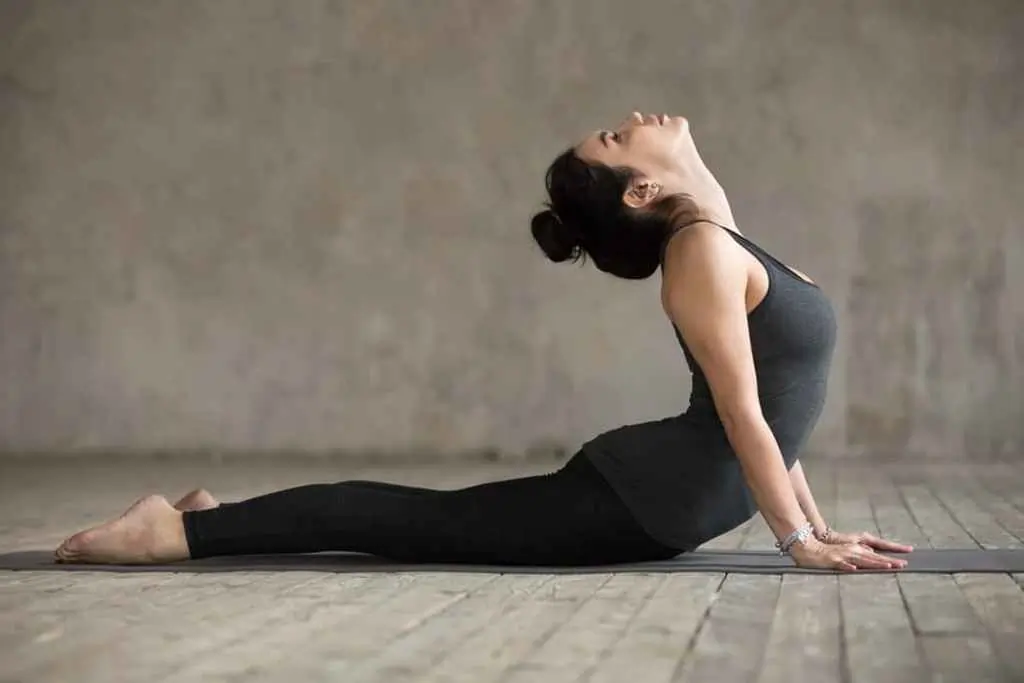
Because it forces the disk material back into its natural position and enables it to start the healing process, this pose successfully eliminates back discomfort related to a herniated disk.
This pose is particularly beneficial if you have lower body symptoms that you can limit to your lower back.
- By lying on your stomach, you can perform this pose as a full stretch or as a half stretch. For a half stretch, support yourself on your elbows and secure your hip bones to the ground. After 15 seconds of holding this stretch, return to your starting position. Ten rounds of this should be repeated.
- Try to hold yourself up with your hands in a full arm extension after you are at ease with the half-stretch. Then, slowly bring your torso upward to complete the position.
Cat-Cow
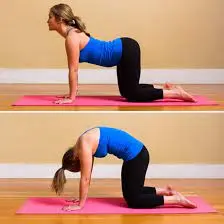
In order to relieve strain on your spine and assist in generating space between the disks that are giving you discomfort, this stretch incorporates two yoga positions. It also promotes some spine movement and aids in the healing process.
- Get on your hands and knees and gaze up to perform this position. Imagine your low back arching as a thread pulls your belly button to the floor. After you release the breath, curve your back and look down at your chest. For three rounds, do these alternating motions ten times.
Standing Extension
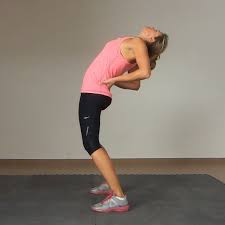
The routine hunch that puts tension on your back can be overcome with this workout. This facilitates the disks’ movement into a neutral state.
- Start this workout by standing up straight and maintaining good posture. Start by pushing your pelvis forward while placing your hands on your lower back. Continue to stretch your back until your eyes touch the ceiling. For three rounds, begin by performing this motion ten times.
Bird- Dog
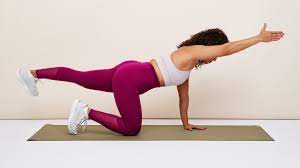
By strengthening the deep spinal muscles and improving low back muscular stability, this exercise helps to maintain proper posture. It is essential to use your abdominal muscles throughout this exercise to support spinal stability and alignment. By improving posture, this exercise will help you avoid herniated disks in the future.
- To guarantee correct alignment, begin this exercise on your hands and knees with your hands just beneath your shoulders and your knees bent. Ensure that your knees are properly aligned with your hips, and your shoulders are aligned with your hands. Keeping your left arm in line with your torso, begin by extending it out. Keeping your right leg in line with your chest, kick it out simultaneously. After a few moments of holding this position, go back to where you were before. Proceed to the other side. For three rounds, switch between each side ten times. To get the most out of this exercise and reduce the chance of damage, it is best performed slowly and carefully.
Exercises to Avoid
Activities with a High Impact
High-impact exercises like running and leaping can strain the spine and make a herniated disc worse. The spinal discs are under a lot of stress from these activities, which raises the possibility of further harm and discomfort.
Excessive Weightlifting
Your lower back may experience undue strain when lifting large weights, especially if you do it incorrectly. Avoid heavy-weight workouts that might worsen a herniated disc, such as overhead presses, squats, and deadlifts.
Rotating Motions
Exercises that cause the spine to twist, such as yoga positions or Russian twists, might make a herniated disc worse. These motions may exacerbate discomfort and put more strain on the damaged disc.
Crunches and Sit-Ups
Conventional crunches and sit-ups might put more strain on the lumbar region. Flexing the spine during these workouts might exacerbate a herniated disc. Choose activities that strengthen your core without putting undue strain on your back, like planks.
Forward Bends and Toe Touches. Toe touches and forward bends are examples of bending forward from the waist, which can place excessive strain on the lower back. These motions might increase pain and suffering and worsen a herniated disk.
Surgical Treatment for a Herniated Disk
In nine out of ten cases, herniated disks resolve on their own or with nonsurgical therapy. Your doctor can advise surgery if no other therapies are able to alleviate your problems. Your spinal cord and nerves can be relieved of pressure using a variety of surgical treatments.
Rarely, nerve damage to the bladder or colon may result from a large ruptured disk. Emergency surgery could be necessary for such. Surgery for a herniated disk may be necessary in non-emergency situations if no other therapies are effective. The purpose of spinal decompression surgery, which can be done in a variety of methods, is to release pressure on your nerves.
Microdiskectomy is the most prevalent technique. Your doctor will create a tiny incision through the skin close to the slipped disk as part of this minimally invasive spine surgery procedure. The herniated portion of the disk will be removed by inserting a microscope and tiny instruments into the incision.
Additional surgical possibilities for therapy include:
- Diskectomy.
- laminotomy.
- laminectomy.
- surgery on an artificial disk.
- Fusion of the spine.
Complications
Your spinal cord finishes just above your waist. The cauda equina, a collection of long nerve roots that resemble a horse’s tail, is what continues into the spinal canal.
The entire spinal canal, including all of the cauda equina’s nerves, may occasionally be compressed by a disk herniation. Rarely, urgent surgery may be required to prevent irreversible paralysis or weakening.
Get immediate medical help if you have:
- Deteriorating symptoms. Weakness, numbness, or pain may worsen to the point where it interferes with day-to-day functioning.
- Either bowel or bladder problems. Even when the bladder is full, incontinence or difficulty peeing can be caused by cauda equina syndrome.
- Saddle anesthesia. The inner thighs, the backs of the legs, and the region surrounding the rectum are all affected by this increasing loss of feeling
Prevention
- Work out. The spine is stabilized and supported when the trunk muscles are strengthened.
- Keep your posture straight. This lessens the strain on your disks and spine. Maintain a straight and aligned back, especially while spending a lot of time sitting down. When lifting large goods, make sure your legs, not your back, do the majority of the lifting.
- Keep your weight in check. Being overweight increases the strain on the disks and spine, increasing the risk of herniation.
- Give up smoking. Steer clear of tobacco products.
FAQ
Which three symptoms indicate a herniated disk?
The following are some typical signs of a slipped or herniated disc:
One side of the body has pain.
One area of the leg, hip, or buttocks may be sharply painful, while other areas may be numb.
severe ache above or close to the shoulder blade, or pain when you move your neck.
A herniated disc is caused by what deficiency?
It has been demonstrated that vitamin D (VD), which binds to the vitamin D receptor (VDR) to provide its biological effects, is essential for both preventing and treating IDD. VD insufficiency has been linked to a higher risk of lumbar disc herniation in patients, according to research.
Are your fingertips able to detect a herniated disc?
You can’t feel one with your fingertips because the spinal discs that act as shock absorbers for your vertebrae are too distant from your skin. You will need to see your physician to get a proper bulging disc diagnosis. They will inquire about your recent activities and symptoms.
What exacerbates a disc herniation?
High-impact activities for spine doctors. Running, leaping, and lifting large weights can cause the spine to jolt, which puts further strain on the ruptured disc. These motions might worsen discomfort by increasing inflammation and nerve compression. Instead, choose low-impact activities like walking or swimming.
What is a herniated disc’s underlying cause?
The most frequent cause of disc herniation is a degenerative process where the nucleus pulposus weakens and loses moisture as people age. A progressive disc herniation that may result from this procedure may produce symptoms. Trauma is the second most frequent cause of disc herniation.
Reference
- Herniated disk – Symptoms and causes. (n.d.). Mayo Clinic. https://www.mayoclinic.org/diseases-conditions/herniated-disk/symptoms-causes/syc-20354095
- Mitchell, G. (2024, August 15). Five Safe Exercises for Herniated Disk Back Pain | NJ Spine & Ortho. NJ Spine & Orthopedic. https://www.njspineandortho.com/safe-exercises-for-herniated-disk-back-pain/
- Herniated disk (Slipped or bulging disk). (2025, September 4). Cleveland Clinic. https://my.clevelandclinic.org/health/diseases/12768-herniated-disk
